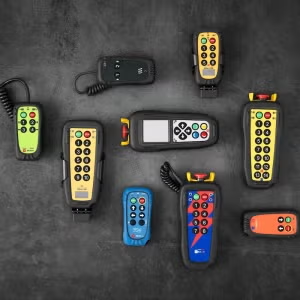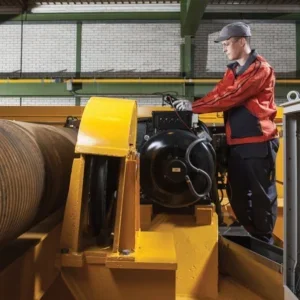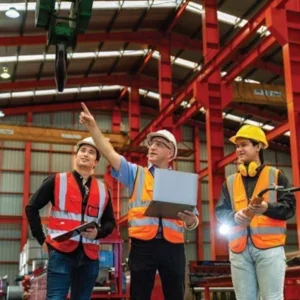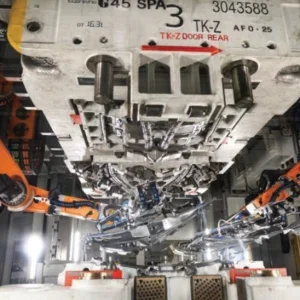Deadline: 10 May 2006
Contact: Dale Helsley, email: dale.helsley@tinker.af.mil, Phone +1 (405) 739-3625, Fax +1 (405) 739-7423, Department of the Air Force, Air Force Materiel Command, Tinker AFB OC-ALC – (Base Contracting), OC-ALC/PKO 7858 5th Street Ste 1, Tinker AFB, OK, 73145-9106
Solicitation number: FA8101-06 -T-0044
The contractor shall provide sixteen 10 US ton capacity double-reeved (4/2) electric wire rope hoists, all CMAA class D. The hoists should be have a low-headroom design with less than 31″ from load eye to top side of lower rail.
They should be able to enter thrust frame at 1.5″ higher than minimum entry height without exceeding hoist safe height limit regardless of dimensions of hoist delivered. They should also be able to traverse and fit into all spaces and situations required by existing hoist, without creating new-fit situations, unless the new deficiency is solved by this contract.
Also:
The Hoist shall be capable of being hung from an articulated trolley.
Hoist provided shall provide 25′ lift height, @ 4 & 25 fpm.
Wire rope shall be minimum IWRC grade, rated to be capable of a proof load of 150% of hoist rating.
Hoist shall be equipped with a multiple disc mechanical load brake.
Electric load brake shall be equipped with transient voltage suppressors to prevent coil failure.
Hoist operating voltage shall be 460 volts AC, 60 Hz. nominal 3 phase single speed windings with class ‘F’
insulation.
Hoist motor shall be rated for inverter duty.
All motor circuit wiring shall use shielded cable specifically designed for inverter service.
Install 3% input reactor on hoist VFD inputs.
The hoists shall be equipped with a position output shaft and position limit switch mounting area suitable
for attachment of an existing position transducer. (such as GEMCO 2006-402-L)
Replace sixteen (16) existing load cells with units designed for maximum hoist rating.
Replace or refurbish 32 hoist support trolleys.
Section 2. Variable Frequency Drive (VFD):
Contractor shall ensure that:
a. The VFD rating shall be sized appropriately for driving the new hoist.
b. The VFD shall be designed specifically for use with overhead lifting applications.
c. The VFD shall be by Power Electronics International Inc.
d. The VFD shall be capable of providing 300% overcurrent to the output load, for additional starting torque, without damage to the VFD.
e. The VFD shall have a maximum rated operating temperature of no less than 60°C.
Section 3. Trolley drives:
c. Contractor shall refurbish existing or provide new trolley drives.
a. Trolley drives shall be compatible with existing Acco Supertrack track.
b. Shall be capable of operating at 33 & 100 fpm.
c. Shall utilize a resilient drive wheel.
d. New trolley drive shall be sized for the capacity of the hoist loads per CMAA.
d. If trolley drives are refurbished, Contractor shall perform the following:
a. Inspect gearbox for tooth damage, teeth showing damage greater than .032″ shall be replaced.
b. Inspect shafts for damage that would create runout or affect seals or bearings, and replace if damaged.
c. Replace all wearing components (bearings, seals, etc)
d. Perform high-voltage insulation breakdown test, rewind all 8 trolleys if any fails this test.
Section 4. General:
Contractor shall:
a. Ensure that installed hoists shall be capable of lifting each adapter frame currently tested in B3234 from its stand, to the build-up floor or F101 intermediate stand, lowering the frame onto the engine, lifting the engine and conveying it into the thrust frame in the cell, and then reversing the process to unload it from the cell and back to the trailer.
b. Provide full service and maintenance manuals, including model number and original manufacturer’s name and contact information.
c. Provide full parts list with part id numbers and complete illustrated parts breakdown.
d. Ensure all external fasteners are safety wired or mechanically locked using flex-lock, nylon inserts, or where not feasible, thread locking compound.
e. Ensure that, unless geometrically unfeasible or detrimental to function of the hoist, all bolts have a minimum of three (3) threads showing through nut.
There are three separate control issues with the eight existing monorail hoist systems.
1.3.1. The switch logic/laser/timer load positioning controls allow potentially dangerous over/under slack conditions to occur when using the monorail hosts to lower engines into the facility thrust frames.
1.3.2. The automated system currently allows hoist rope to come off the drum, causing the cable to jump the rope land, allowing large impact forces to be transmitted to the drive train, monorail track and engine; or it maintains tension in the rope, transmitting vibration forces through the hoist drive train, hoist electronics and monorail.
1.3.3. The existing automatic positioning hardware, sensors and controls, when combined with the monorail-to- thrust frame dimensions that vary by a few inches in each of four(4) cells, do not provide consistent entry and exit clearance between the thrust frame and the adapter frame, allowing some hoist/cell combinations to interfere/collide.
1.4. Modifications/Repair. The Contractor shall modify the eight (8) monorail hoists and controls, correcting the control issues as necessary to obtain optimal satisfaction for the purpose intended.
1.4.1. The Contractor shall provide a repeatable automatic slack function as part of the process of inserting the adapter frame into the facility thrust frame.
1.4.2. The Contractor shall prevent over-slacking of hoist ropes to the point of losing block weight against the rope or allowing the rope to skim drum grooves.
1.4.3. The Contractor shall ensure sufficient slack remains after locking the adapter frame into the thrust frame to prevent vibration transmission through lift ropes.
1.4.4. The Contractor shall provide repeatable automatic full-up in-cell minimum height so as to allow all frames to enter the thrust frame from above, in all cells, without interference. In-cell and end-travel switch paddles are currently positioned to allow the adapter frame to enter the thrust frame from below.
1. The system provided by the Contractor shall provide unimpaired adapter frame loading, clearance and function in all hoist-cell-adapter frame combinations.
Section 5. Phasing/Proof of Concept:
a. Purchase, install and integrate equipment for one (1) hoist train, and demonstrate full functionality, prior to purchasing the balance of the equipment for the remaining seven hoist trains.
b. The Government reserves the right to award either one (1) or eight full hoist trains (two hoists, one VFD, and all appurtenances and labor required to make a fully functional hoist train) by this contract, based on the outcome of the demonstration hoist.
Per Far 52.212-2, Contractors’ proposals will be evaluated based on their responses to the following:
1. Questionnaire – Describe, where applicable, projects you have done that involved similar work. Engineer will evaluate responses to the following:
Do you employ control electricians and control programmers who are trained on Allen Bradley Programmable Logic Controllers (PLC)?
Does your company have a current software support agreement with Allan Bradley for the MicroLogix 1500 controller?
Has your company installed control systems using the Allen Bradley MicroLogix 1500 controllers?
What measures would you take to address the RFI/EMI issues, from both radiation and susceptibility standpoints?
What measures would you take to prevent hoist hardware installed by this contract from becoming FOD? .
Describe your plan to interface the hoist you intend to install with the existing control system.
Describe in detail the load cell arrangement you propose. Describe your plan to replace or refurbish the trolley tractor unit.
Describe in detail your process for insuring that the hoist, with its load, will operate within the mechanical/dimensional restraints of the system. Address headroom, width, end approach, turning radius,
compatibility with existing tractor and spreader bar, or new (per your intent), interference with existing facilities, clearance through the switches, interference with the load.
Describe in detail your method of determining the maximum lifting capacity of the monorail for load
testing.
Describe in detail your proposal to provide reliable slack in hoist ropes when load is set in frame.
Describe in detail your proposal to prevent conditions in which over-slack allows ropes to come out of rope lands on drum.
2. Engineering evaluation: per the Contractor’s proposal and the questionnaire above, does the Proposal address:
The Contractor has insured the hoist selected will fit the operating envelope.
The materials proposed will serve Test Cell operations with a minimum of maintenance.






